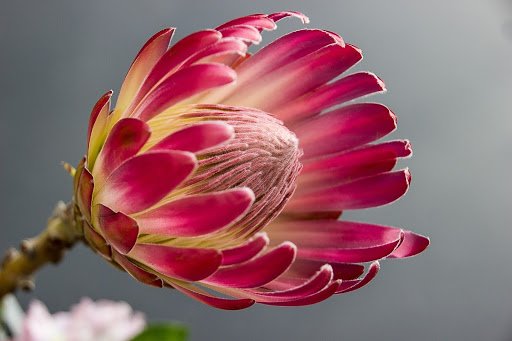Protea

The artichoke-like appearance of the protea flower is a beauty in itself. It is available in several different colour schemes, but the pink-coloured proteas are the most beautiful. They are considered to be one of the oldest flowering plants on the planet, dating back to 300 million years. In 1735, botanist Carl Linnaeus, also known as the father of taxonomy named and classified protea. The name protea signifies Proteus, who is the son of Poseidon. Proteus translates to a shape-shifter, and since the flower is found in a variety of different shapes and colours, this name best suits it.
The genus Protea was named in 1735 by Carl Linnaeus, possibly after the Greek god Proteus, who could change his form at will, possibly because they have such a wide variety of forms. Linnaeus's genus was formed by merging a number of genera previously published by Herman Boerhaave, although precisely which of Boerhaave's genera were included in Linnaeus's Protea varied with each of Linnaeus's publications.
The family Proteaceae to which Protea species belong is an ancient one among angiosperms. Evidence from pollen fossils suggests Proteaceae ancestors grew in Gondwana, in the Upper Cretaceous, 75–80 million years ago. The Proteaceae are divided into two subfamilies: the Proteoideae, best represented in southern Africa, and the Grevilleoideae, concentrated in Australia and South America and the other smaller segments of Gondwana that are now part of eastern Asia. Africa shares only one genus with Madagascar, whereas South America and Australia share many common genera – this indicates they separated from Africa before they separated from each other.
Proteas are currently cultivated in over 20 countries. Cultivation is restricted to Mediterranean and subtropical climates. Three categories of traits have to be considered before developing a new cultivar. The yield or production capacity of the cultivar must be considered. The ease of handling and packaging of the cut stems and the last category is to consider the perceived market value of the cultivar The cultivation of a Protea plant is time-consuming, so good planning when developing the cross combinations and goals are of great importance of the breeding programme. Some protea flower species, like the king protea flower, are self-pollinating flowers. Other protea species, however, such as P. cordata, P. decurrens, and P. scabra are self-incompatible, thus rely on cross-pollination for successive seed set. The main vectors responsible for the transfer of pollen in protea cultivation are birds, insects, and wind. Some Protea species exhibit both self-pollination and cross-pollination as a method of reproduction. Cross-pollination is preferred, though, as a method of reproduction because it provides genetic diversity in the population. When cultivating proteas, breeders use hand pollination as a controlled method to transfer pollen from one flower to another. Proteas usually flower during spring. The general structure of their flower heads consists of a mass of flowers on a woody receptacle. The ovary is protected by the receptacle, thus is not seen when looking at the flower, but the anthers are present at the top of the flower, which can then easily transfer the pollen to the vectors. The common Proteaceae plants, e.g. Protea, Leucospermum, and Leucadendron are diploid organisms, thus they can freely hybridise with closely related species to form new cultivars. Unusually, not all the genera within the family Proteaceae are able to hybridise freely; for example, Leucadendron species cannot be crossed with Leucospermum species because of the difference in their haploid chromosome number (13 and 12, respectively). This genetic incompatibility results in pollinated flowers that yield either no fruit, or seedless fruit, as the resulting plant embryos, from the incompatible pollen and ovum, fail to develop.